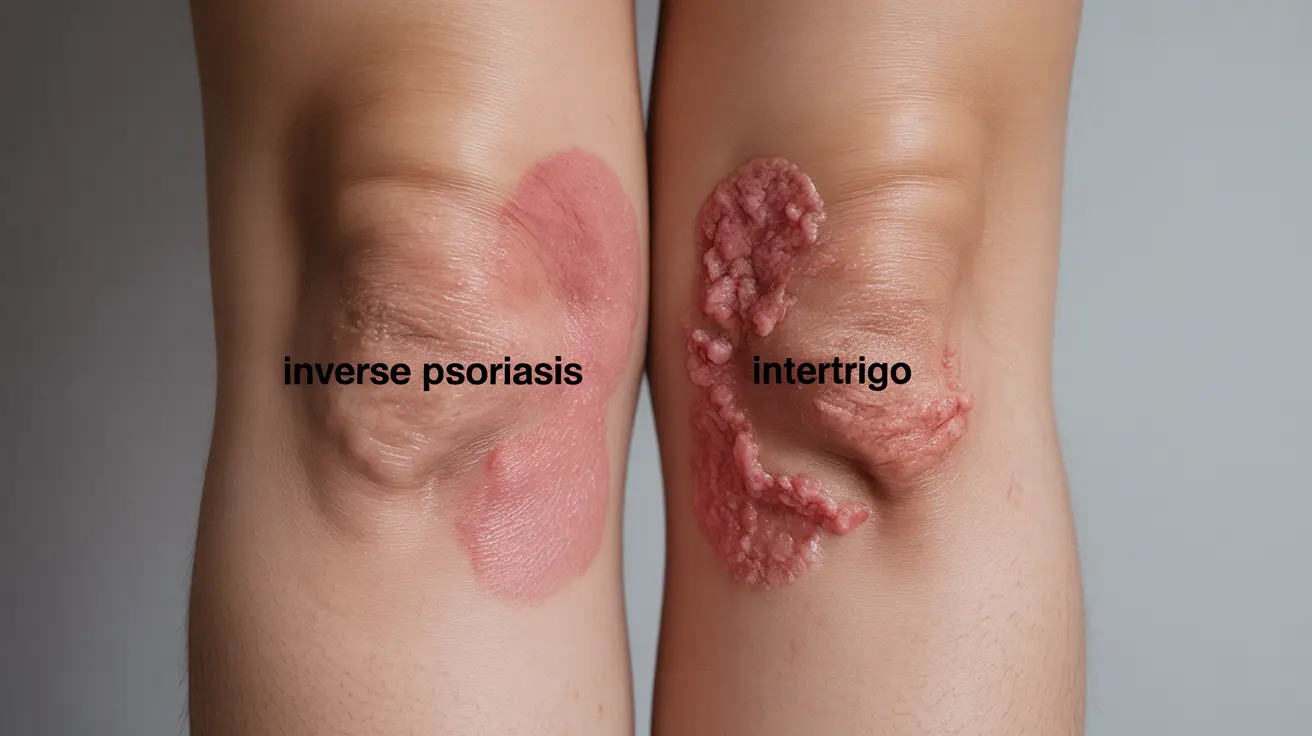When skin rashes develop in body folds, it can be challenging to determine whether you're dealing with inverse psoriasis or intertrigo. While these conditions may look similar and occur in the same areas, they have distinct causes, symptoms, and treatment approaches. Understanding these differences is crucial for proper diagnosis and management.
In this comprehensive guide, we'll explore the key distinctions between inverse psoriasis and intertrigo, helping you better understand these skin conditions and their specific characteristics.
Understanding the Basics of Each Condition
What is Inverse Psoriasis?
Inverse psoriasis is an autoimmune condition that appears as smooth, red, inflamed patches in skin folds. Unlike traditional plaque psoriasis, inverse psoriasis doesn't typically present with scaling due to the moisture in fold areas. It commonly affects areas such as the armpits, groin, under the breasts, and between skin folds.
What is Intertrigo?
Intertrigo is a inflammatory skin condition caused by friction between skin folds, combined with moisture and heat. This creates an environment where bacteria and fungi can thrive, leading to infection. It appears as red, raw-looking skin that may be itchy and uncomfortable.
Key Differences in Symptoms and Appearance
While both conditions can look similar at first glance, there are several distinguishing characteristics:
- Inverse Psoriasis:
- Well-defined, bright red patches
- Smooth, glossy appearance
- May burn or itch
- Often symmetrical on both sides of the body
- Can occur alongside other forms of psoriasis
- Intertrigo:
- Red or reddish-brown rash
- May have satellite lesions
- Often accompanied by a foul odor
- Can become secondarily infected
- May have oozing or crusting
Causes and Risk Factors
Inverse Psoriasis Triggers
As an autoimmune condition, inverse psoriasis occurs when the immune system mistakenly attacks healthy skin cells. Risk factors include:
- Genetic predisposition
- Obesity
- Stress
- Certain medications
- Environmental triggers
Intertrigo Development
Intertrigo develops primarily due to environmental factors:
- Excessive moisture
- Friction between skin folds
- Hot, humid weather
- Obesity
- Poor hygiene
- Diabetes
Treatment Approaches
Managing Inverse Psoriasis
Treatment typically involves:
- Topical corticosteroids (used carefully due to sensitive areas)
- Topical calcineurin inhibitors
- Light therapy in some cases
- Systemic medications for severe cases
- Lifestyle modifications to reduce triggers
Treating Intertrigo
Treatment focuses on:
- Keeping the affected areas dry
- Antifungal or antibacterial medications
- Barrier creams
- Good hygiene practices
- Weight management if applicable
Prevention and Lifestyle Management
Both conditions benefit from preventive measures, including:
- Maintaining a healthy weight
- Wearing loose-fitting, breathable clothing
- Keeping skin folds dry and clean
- Using moisture-wicking fabrics
- Regular bathing and proper drying
Frequently Asked Questions
What are the main differences between inverse psoriasis and intertrigo in terms of causes and symptoms?
Inverse psoriasis is an autoimmune condition causing well-defined, bright red patches in skin folds, while intertrigo is caused by friction and moisture, resulting in a red or reddish-brown rash that may have a distinct odor and can become infected.
How can doctors accurately diagnose whether a skin fold rash is inverse psoriasis or intertrigo?
Doctors typically examine the appearance and pattern of the rash, consider the patient's medical history, and may perform skin scrapings or biopsies. The presence of other psoriasis symptoms elsewhere on the body can also help confirm inverse psoriasis.
What are the most effective treatments for managing inverse psoriasis compared to intertrigo?
Inverse psoriasis typically requires immune-modulating treatments like topical corticosteroids or calcineurin inhibitors, while intertrigo responds well to keeping the area dry and using antifungal or antibacterial medications when needed.
Can moisture and friction make inverse psoriasis or intertrigo worse, and how can these factors be controlled?
Yes, both conditions can worsen with moisture and friction. Control these factors by wearing loose-fitting clothes, using moisture-wicking fabrics, keeping skin folds dry, and applying barrier creams when appropriate.
Is inverse psoriasis a chronic condition, and can intertrigo be completely cured with proper care?
Inverse psoriasis is a chronic condition that can be managed but not cured. Intertrigo, however, can be completely resolved with proper treatment and preventive measures, though it may recur if risk factors aren't addressed.




